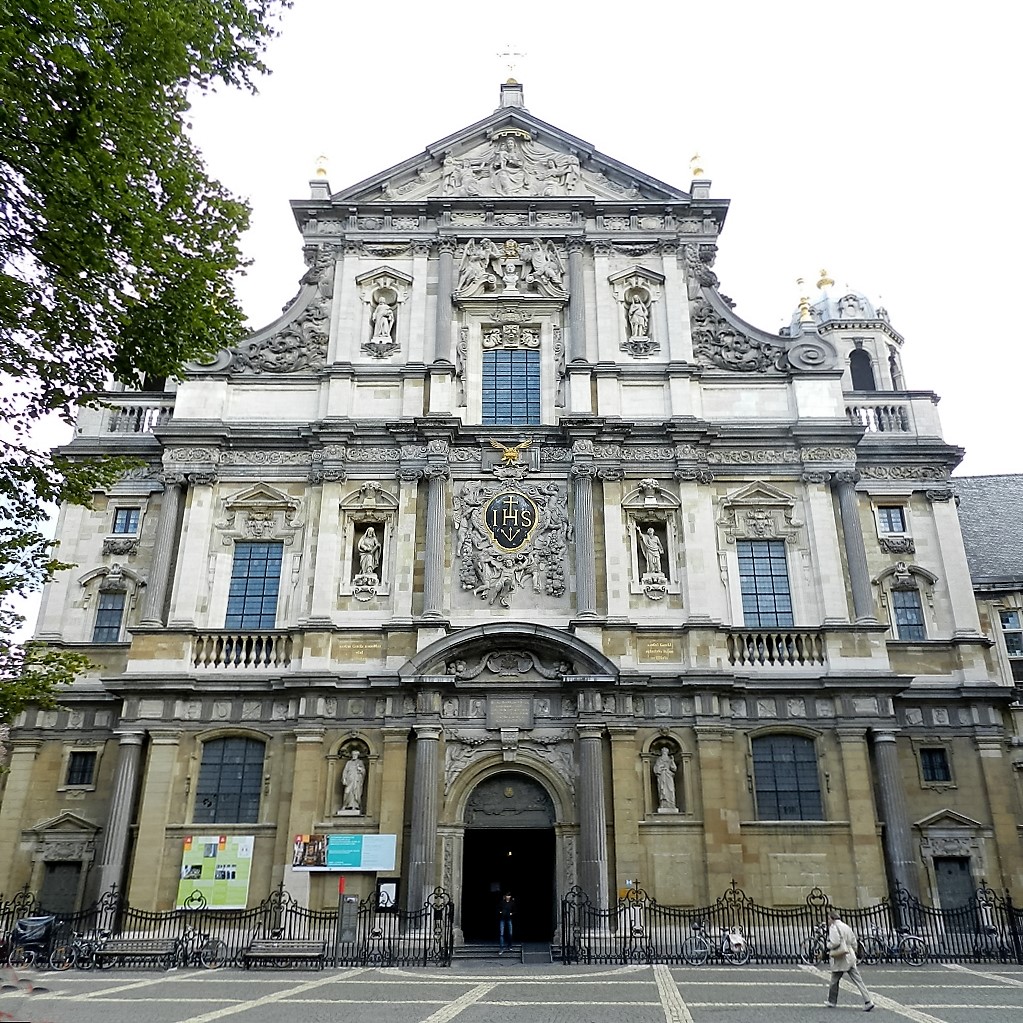The Antwerp jesuit church, a revelation.
Previous history
The first Jesuits in Antwerp (1562–1614)
Once upon a time… there was a student in Paris who had difficulty to pay for his studies, an enthusiastic man, of lower nobility, from the Spanish Basque Country. His name: Iñigo de Loyola (1491-1556). He visited the Low Countries thrice (1529, ’30 and ’31) to beg money from his wealthy compatriots. Formerly a bust with a chronogram at the corner of Lange Nieuwstraat and present Eikenstraat was a reminder of his stay in the commercial metropolis Antwerp. Now there is only a modest plate against the former churchyard wall at the southern entrance to SaintThis is a title that the Church bestows on a deceased person who has lived a particularly righteous and faithful life. In the Roman Catholic and Orthodox Church, saints may be venerated (not worshipped). Several saints are also martyrs. James’ Church. With his Latinised name ‘Ignatius’ he has become world famous as the founder of the Society of Jesus, better known as the order of the Jesuits, which was acknowledged by pope Paul III in 1540.
When years later the Spanish community in Antwerp wanted a chaplain who spoke their mother tongue, they could appeal to the young, active order of Spanish origin. So, the first Jesuit settled here in 1562 and was soon followed by some foreign fathers for the pastoral service to the important Spanish and Portuguese communities. Five years later they were also active as army chaplains in the garrison of the Grand Duke of Alba, which was encamped in the brand-new citadel. For the time being the fathers rented a premise in Meir. In this way Antwerp became the third foundation of the Society in the Dutch speaking region, after Louvain (1542) and Bruges (1560).
They wanted very much to widen their scope of activities with a college for secondary education. Thanks to the generous support of numerous benefactors they bought the famous Huis van Aken, a late Gothic premise surrounding a square inner courtyard, for 34,000 florins in 1574. It was one of the biggest and most magnificent patrician houses in town, built by ironmonger Erasmus Schetz from Aachen at Korte Nieuwstraat and (the now gone) Spuistraat (at the present Campus Carolus of Lessius High School Antwerp). Do you see the narrow door and windows below a higher roof corner in the south-eastern corner of the church square? This is a remnant of it.
The costs of the adaptation works and the building of an aisleless chapel
A small church that is not a parish church. It may be part of a larger entity such as a hospital, school, or an alms-house, or it may stand alone.
An enclosed part of a church with its own altar.
in the garden – another 10,000 florins – were completely borne by the well to do Spaniard F. Frias. Soon the college had some 300 pupils.
Because in 1576 the cruel Spanish Fury passed by their house, the reputation of the Jesuits as Spanish priests was reinforced. And they had to pay for that. For understandably Antwerp chose an anti-Spanish revolutionary rule, and soon this government became distinctly Calvinistic. The Catholic clergy who would not agree with the oath of loyalty to the Republic, had to leave the town, which the Jesuits did in 1578. That the ‘colonels’ of the revolutionary citizen guard settled in one of the college halls, could be a symbolic political move. Moreover, part of the furniture was claimed for William of Orange’s residence in the Citadel. From then the Calvinists would preach in the Jesuit chapel, which they ‘cleared’ of everything that was Roman-Catholic.
In 1585 times changed. After the siege by Alexander Farnese the town had only just been taken over by the lawful Spanish authorities when the next day the Jesuits took possession of their belongings and the third day they celebrated a jubilation massThe liturgical celebration in which the Eucharist is central. It consists of two main parts: the Liturgy of the Word and the Liturgy of the Eucharist. The main parts of the Liturgy of the Word are the prayers for mercy, the Bible readings, and the homily. The Liturgy of the Eucharist begins with the offertory, whereby bread and wine are placed on the altar. This is followed by the Eucharistic Prayer, during which the praise of God is sung, and the consecration takes place. Fixed elements are also the praying of the Our Father and a wish for peace, and so one can symbolically sit down at the table with Jesus during Communion. Mass ends with a mission (the Latin missa, from which ‘Mass’ has been derived): the instruction to go out into the world in the same spirit. in the presence of the governor. The college could reopen its doors.

- Saint Charles Borromeo’s Church
- History & Description
- Introduction
- The historic context
- Square and residence
- Previous history
- The college
- Spatial effects
- Names of streets
- Profess house
- Sodality building
- Façade
- Tower
- Interior
- High altar
- Pulpit
- Confessionals
- Ceiling paintings
- Our Lady’s chapel
- Saint Ignatius chapel
- Chapel of Saint Francis Xavier
- Galleries
- Organ
- Sacristy
- When leaving
- Epilogue
- Bibliography

